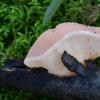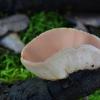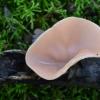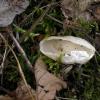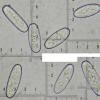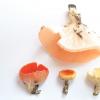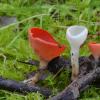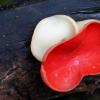
18-12-2025 21:17
Pol DebaenstThe identification took me to Byssonectria deformi

15-12-2025 07:09
 Danny Newman
Danny Newman
indet. Rutstroemiaceae sp. on unk. fallen leavesMc

19-12-2025 10:10
Patrice TANCHAUDBonjour, récolte réalisée en milieu dunaire, a

18-12-2025 17:23
 Bruno Coué
Bruno Coué
Bonjour,je serais heureux d'avoir votre avis sur c

18-12-2025 18:07
Margot en Geert VullingsThese plumes were found on rotten wood.They strong

17-12-2025 18:35
 Michel Hairaud
Michel Hairaud
Bonjour à tous/Hi to everyone I am passing along

15-12-2025 15:48
 Danny Newman
Danny Newman
Melanospora cf. lagenaria on old, rotting, fallen

15-12-2025 15:54
 Johan Boonefaes
Johan Boonefaes
Unknown anamorph found on the ground in coastal sa

15-12-2025 21:11
 Hardware Tony
Hardware Tony
Small clavate hairs, negative croziers and IKI bb
 Dear Friends
Dear FriendsI want to show a nice discovery of pink Sarcoscypha coccinea last 1th February on Q. ilex twig, max diameter 3,7 cm. I know orange, orange-yellow, yellow, white coccinea... Someone has already seen the species in this habitus ?
Thank you

I only know Sarcoscypha jurana white.
Good luck.
in the famous Japanese photo-book by R. Imazeki, Y. Otani and T. Hongo, you'll find on p. 555 a picture of a pale pink Sarcoscypha vassiljevae Raitv. which is strikingly similiar to your photograph. I have an article by Raitviir (Eesti NSV teaduste akad. Toimetised, 14,1965: 539-535) describing the species, but it's in Russian, so I can't even find out the colour of the hymenium. In Zotto's master thesis, however, the taxon is mentioned as "pure white" .
According to the Raitviir article, the spores of vassilijevae - 21-26(-29) x 10-13um - are remarkably smaller than those of his S. coccinea (at that time including, probably, austriaca and/or jurana) with 30-40 x 12-15um. Furthermore, the vassiljevae-spore contains one large central oil drop.
The type of S. vassilijevae comes from Wladiwostok ... a long way from your collection site, I'd guess...
Best regards
Till

In my "master thesis" I made a chromatogramm of the red pigment, showing that it consists of a number (three?) of differently coloured substances. I assume that a genetic defect provokes one or two of these being not formed, or even none at all.
In austriaca and jurana I know more of these aberrant collections, partly in mixture with the red ones. But such rose colour I cannot recall.
Yes, vassiljevae i remember white, and I think I translated the Russian text at that time.
Carlo, if you have a microphoto with scale or spore size we could see that your identification is right. On Qu. ilex I only expect S. coccinea with such size.
Zotto

just for curiosity, here is a collection from Japan (presumably by Kiyoshi Iguchi) called S. vassiljevae: http://simocybe.sakura.ne.jp/yosooi-chawan-take.htm
Here some informations I learned with Google translator: apothecia are 3-6cm in dm, "pale yellowish white to pale cream to the entire but, often faintly beautifully tinged with pink", asci 273.8-336.4 × 12.6-13.9 µm, IKI-, spores "surface in oval smooth, colorless in thin wall to moderately thick-walled, and does not react to Meltzer solution, contains 1-2 pieces of oil droplets inside, size 17.1-26.0 × 10.-13.4 µm".
Found on Hokaido and Honshu on partly buried dead branches of Taxus baccata.
Regards
Martin


Yes Zotto, spores seems typical to S. coccinea... (25,5-33,8 x 9,8-12,4)
Pink sample grew close many typical S. coccinea samples.
The "genetic defect" concerns already mycelium (?) because the discolored specimens do not never come on the same branches of the typical specimens: they are always isolated.
Clearly the pink specimen must have a low concentration of total carotenoids...Do you think that the higher carotenoid fraction could be the third fraction in your work ? 2' dehydro-plectaniaxanthine-1'ester ?
I show you last days collections sent me by a Greek friend with red, orange and white-cream maybe similar to Berthet collection in Arpin ... I add also a complete white 2014 collection (mine).
Best

I did not remember about the chemistry, only that differently coloured carotenoids are involved.
It is too long ago, and I simply compared with the literature. But you may be right with this fraction II. Regrettably I did not photograph the chromatography.

I did not remember about the chemistry, only that differently coloured carotenoids are involved.
It is too long ago, and I simply compared with the literature. But you may be right with this fraction II. Regrettably I did not photograph the chromatography.

